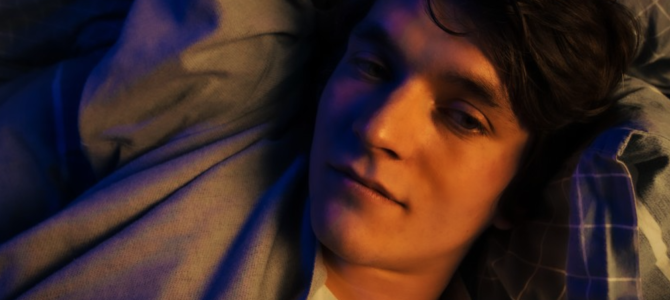
Watching the virtual theatrical production of “The Picture of Dorian Gray,” I wondered if anyone involved in the show had ever read the novel. Director Tamara Harvey and writer Henry Filloux-Bennett profoundly fail to understand one of the greatest novels ever written, butchering the characters’ arcs and themes to create a convoluted, confusing product.
“The Picture of Dorian Gray” is a co-production between five theater companies across England and Wales: Barn Theatre, Lawrence Batley Theatre Huddersfield, New Wolsey Theatre, Oxford Playhouse, and Theatr Clwyd. Audiences of the prerecorded production receive a link that provides access to the play for 48 hours. Tickets are available online through April 17, but I’d advise skipping this one if you value competent storytelling or have any affection for Oscar Wilde’s novel.
The play has an intriguing concept, taking Wilde’s story of a man overwhelmed with his own youth and beauty and transposing him into the image-obsessed world of social media. However, the intriguing concept is wasted on an incoherent story with contradictory characters and confused messaging. It’s almost impressive how wrong the creative team got this one.
“The Picture of Dorian Gray” tells the story of a college student and would-be influencer whose life is changed when his software developer friend provides him a filter that makes him always appear perfect when viewed through a screen. His online following skyrockets while his morality and social isolation plummet, and his face and body begin to bear the evidence of his misdeeds — an inversion of the traditional aging painting and eternally perfect face.
“Dorian Gray” used a mockumentary format, in which Stephen Fry interviewed two of the five central characters — the only ones to survive the story, as text explains at the show’s outset. Oftentimes, a mockumentary can provide insights into the characters, allow various perspectives to be explored, and force heroes and villains alike to confront their actions and beliefs head-on.
None of that was used here. Instead, the talking-head interviews were a cheap means of naturally adding narration in an effort to tie together the found footage. It’s a cheap ploy and comes across as such. Nothing is learned about Lady Caroline or Lord Henry that the chronological moments did not already demonstrate, and the framing device diverts substantial time away from the main plot.
The plot of both the novel and play is not particularly complicated, with the depth arriving through the ethical questions raised and the well-drawn characters. For so straightforward a tale of one man’s descent, “The Picture of Dorian Gray” is shockingly confusing, with weak storytelling creating frustrating inconsistencies.
Harvey and Filloux-Bennett clearly had something to say about the dangers of social media, but I can’t exactly tell you what that is. At first, the play had a clear, if preachy and obvious, message that social media breeds isolation, insecurity, and depression; young people have become too obsessed with their image and an online following, when genuine human connection is what truly matters.
However, at some point, the story takes an unexpected detour into fake news and misinformation, with Dorian spreading QAnon conspiracies as a sign of his deterioration. The early focus on appearance obsession suited the novel’s themes nicely, but the shift in tone confused the messaging and likewise made little sense in Dorian’s devolution.
The normally solid and likable Fionn Whitehead was woefully miscast as the eponymous character. He effectively captured the characters’ early awkwardness and his rare moments of sincerity, but he seems uncomfortable in the darker aspects of his character. Whitehead likewise lacks the magnetism that explains Gray’s borderline supernatural appeal. He seems artificial when Gray ought to be at his most charming, and downright off-putting during the darker moments, laking the required charisma.
Some of the worst alterations come from Filloux-Bennett’s intrinsic alterations to Basil Hallward (Russell Tovey) and Lord Henry Wotton (Alfred Enoch), the dual influences on Dorian Gray. Filloux-Bennett appears to have taken aspects of both characters, blended them together, and churned out two confusingly characterized people with only a faint resemblance to their literary counterparts and a clear misunderstanding of what made each man work.
Typically, the pair serve as the opposing sides to Dorian’s morality. In the novel, Basil is the artist who paints the portrait that captures Dorian’s evil. He loves the uncorrupted version of Dorian and, while he values beauty, rejects hedonism in favor of a more measured, conscience-driven life.
Lord Henry is the opposite. He is easily one of the novel’s most entertaining creations, an ostensible libertine whose shocking language and wild ideas surrounding the futility of marriage and polite society belie a far more conventional life. He encourages Dorian’s dark side as a form of vicarious living.
Enoch’s take on the role is a far cry from Wilde’s, a flamboyant college student in a casual sexual relationship with Dorian. His fascination and affection are towards Dorian as a person, not for his looks, robbing Henry of the shallow wickedness that sets him apart in the novel.
Enoch plays the role convincingly, but his role offers him little to do other than flirt with the protagonist and drop famous Wilde quotes as one-liners. The play ends suggesting that the relationship between Dorian and Henry was a true and genuine love (platonic or romantic is a little unclear), which completely negates his narrative position as the corrupter.
Much of Henry’s best and most morally complicated lines are actually given to Basil, who serves as the moral center of the novel and, to a lesser extent, the play. Basil’s characterization is wildly confused, with the text sometimes placing him as the earnest voice of reason and other times framing his relationship with Dorian as toxic.
Filloux-Bennett made the baffling choice of presenting Basil as married with children, but repressing his attraction to the much-younger Dorian despite apparent sexual tension. Whether he is protective or predatory and if his feelings are returned are left vague, not due to a thoughtful creative choice but through the play’s inherent contradictions.
Basil likewise has the least screen-time of the five central characters, frustratingly wasting a very talented actor. Tovey’s expressive eyes and subtle shifts in body language and facial expression communicate so much emotion and depth. Tragically, he is kept off-camera for most of the play, instead focusing on his hands, his voice behind the camera, and even an animated YouTube avatar. The one scene in which he is kept onscreen for the majority demonstrates why hiding him was a mistake, as his nonverbal reactions imbue the sequence with needed complexity.
Rounding out the ensemble were Lady Caroline (Joanna Lumley), a socialite who takes an interest in Dorian, and Sybil Vane (Emma McDonald), an aspiring actress and singer he briefly dates. Both women are interesting modernizations of their literary counterparts, and Lumley and McDonald portray them well. yet neither are given any real development or depth, mostly existing as plot devices more than people.
Framing Dorian as an influencer obsessed with his online appearance is a clever update to the source material, allowing questions of appearance, morality, and isolation to play out against a complicated influence in modern society. I sincerely hope that someone else will tackle this concept competently, theatrically or cinematically. Sadly, this play fails, both as a stand-alone story and an adaptation of a beautiful, thought-provoking novel.









